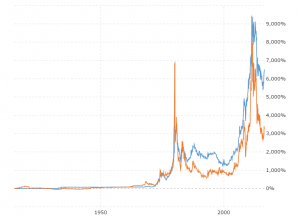US Marines World War One Service Medal
The big coin news of the moment is the recent release of a silver dollar coin and several medals commemorating the 100th anniversary of the end of World War One – once called ‘The Great War’. Each medal honors the activities of one service in that war, and some depict critical events in the war history of the service. With that in mind, let’s expand on some of these medals, and talk about the images, and the creation of the designs. One of the most significant and interesting battles in depicted on the medal for the U.S. Marines, so let’s look in more detail at that one. We may return to medals commemorating other services at a later time.
The commemorative medal for the U.S. Marines depicts the Battle of Belleau Wood. After President Woodrow Wilson asked the American Congress for a war to end all wars (that would) make the world safe for democracy, Congress declare war on Germany on April 6, 1917. It took some time for troops to be recruited, and to arrive in Europe, and for the Marines it was June of 1918 before they engaged in a significant battle. That chance came in what is called the Spring Offensive. German battle-hardened troops, back from the Russian Front following Russia’s withdrawal from the war, were coming close to breaking through the allies’ line protecting the city of Amiens and the French capital itself, Paris. The German advance was so rapid that their supply-lines became over-extended, and they were forced to dig in. They constructed heavily-fortified positions, and one of these was at a place then called Belleau Wood. The 2nd and 3rd Divisions of the US Army were ordered to clear the position, and half of the 2nd Division was the 4th Marine Brigade.
The way to the woods was across open fields, strafed by German machine guns, and it was so dangerous that French officers advised the Marines to withdraw. US Marine Captain Lloyd Williams replied to them, “Retreat? Hell, we just got here.” After suffering many casualties, the Marines were able to reach the woods, where the trees offered some protection form the machine guns. A combination of accurate sniper fire and fierce hand-to-hand fighting with bayonets, and the immense courage of these fresh troops, saw the Germans defeated on June 26. They called the Marines “Teufel Hunden”, or, “Devil Dogs”. Over 1,800 allied troops were killed, but the victory damaged German morale, and boosted that of all the allies. By November 11 the war was over.
As for the medal itself, the design is by Chris Costello, a graphic designer and part of the Mint’s Artistic Infusion Program. He has designed many coins and medals for the Mint. His design for the obverse shows two Marines after the battle. While one stands guard, the other kneels, head bowed, in respect for his fallen comrades. The inscription reads, WOODS NOW U.S. MARINE CORPS ENTIRELY, which was the message sent to headquarters immediately after taking the German position. Michael Gaudioso sculpted the obverse. The reverse was designed and sculpted by Joseph Menna, a sculptor-engraver employed by the Mint. It shows the WWI version of the Marines ‘Eagle, Globe, and Anchor’ emblem. The words OVER THERE! are part of the inscriptions on the reverse, and this is the title of a popular song from 1917 written by George M. Cohan. The medal is 90% silver and 10% copper, with a proof finish. It is 1.5 inches in diameter, and weighs 26.73 grams.








